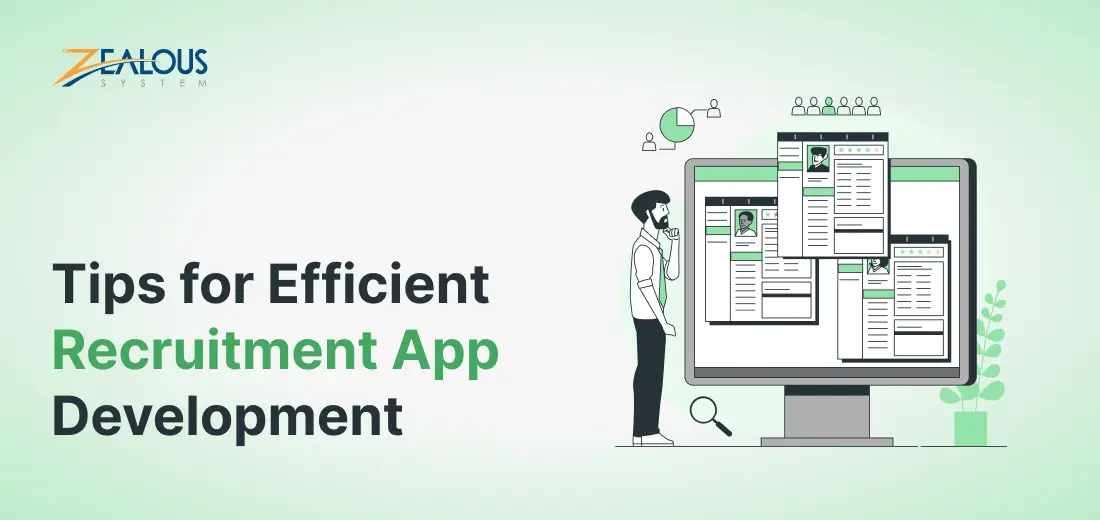
We use cookies and similar technologies that are necessary to operate the website. Additional cookies are used to perform analysis of website usage. please read our Privacy Policy
Recruitment App Development: An Experienced Developer’s Guide

Recruitment apps, also known as applicant tracking systems (ATS) or HR software, have become essential tools for modern HR and recruitment processes. These apps are designed to simplify and streamline various aspects of the hiring process, offering practical solutions for both employers and job seekers.
In this blog, we will explore the world of recruitment app development, focusing on the crucial features that make these apps invaluable. We’ll also guide you through the process of creating a recruitment app, from the initial concept to the final step.
By the end of the blog, you will be well-prepared to start on the journey of building a scalable recruitment app that not only saves time and resources but also enhances the experience of all those involved in the recruitment process.
Before diving into the recruitment app development process, let’s first clear the base and understand,
What Is Recruitment App Development?
Recruitment apps, also known as applicant tracking systems (ATS) or HR software, have become essential tools for modern HR and recruitment processes. These apps are designed to streamline and simplify various aspects of the hiring process.
A recruitment app is basically a mobile or web application that helps businesses and candidates with the recruitment process. These apps can automate many of the tasks involved in hiring, such as job posting, resume screening, scheduling interviews, and making offers.
This can help businesses to save time and money, and it can also improve the candidate experience.
Here Are The Key Features Of A Recruitment App
Recruitment apps have become increasingly popular in recent years, as they offer several advantages over traditional recruitment methods. Here are some of the key features of a recruitment app:
Job Listings
- Job listings are at the heart of a recruitment app. Employers can create comprehensive job descriptions, specifying not only the job title but also the responsibilities, qualifications, and other essential details.
- They can categorize listings by department, location, or other relevant criteria to help job seekers easily find positions that match their skills and preferences.
- Some apps offer the option to include videos, images, and other multimedia elements to make job listings more engaging and informative.
Candidate Profiles
- Job seekers can create detailed profiles within the app, providing a comprehensive overview of their qualifications, skills, work history, education, and certifications.
- Candidates may also have the option to upload their resumes or use an integrated resume builder tool to create professional-looking resumes.
- Features like portfolio uploads or links to professional websites can help candidates showcase their work and achievements.
Application Tracking
- Application tracking features enable employers to efficiently manage and track job applications from various sources.
- They can categorize and prioritize applications, making it easier to review candidate qualifications and progress in the hiring process.
- Many apps offer customizable application statuses (e.g., “under review,” “interview scheduled,” “offer extended,” etc.) to provide a clear overview of each candidate’s status.
Communication Tools
- In-app messaging and email integration facilitate seamless communication between employers and candidates.
- Employers can use these features to schedule interviews, share important information, and provide feedback to candidates directly through the app.
- Communication history is often tracked within the app, ensuring that all interactions are well-documented.
Screening and Assessment Tools
- Some recruitment apps include built-in assessment tools to evaluate candidates’ skills and qualifications.
- Employers can create customized assessment tests or use predefined assessments to gauge a candidate’s suitability for a role.
- These assessments may include multiple-choice questions, coding challenges, or other specific evaluations tailored to the job’s requirements.
Analytics and Reporting
- Employers can utilize analytics and reporting tools to track key recruitment metrics, such as time-to-fill, source of hire, and cost per hire.
- This data helps in assessing the effectiveness of the hiring process and making data-driven improvements.
- Customizable reporting dashboards and visualizations allow for a clear and comprehensive overview of recruitment performance.
The Recruitment App Development Process
As a leading recruitment app development here we have made a step-by step guide to start your recruitment app development process.
Concept and Market Research
To start, you should clearly define the concept and objectives of your recruitment app. It’s crucial to conduct comprehensive market research to gain insights into the recruitment industry, identify trends, and discover areas where your app can fill gaps. Understanding the specific needs of both job seekers and employers is essential at this stage to shape your app’s features and functionalities.
Design and Prototyping
Once you have a well-defined concept, the next step is designing the app’s user interface (UI) and user experience (UX). Creating wireframes and prototypes helps you visualize the app’s layout and interactions. Design should focus on making the app user-friendly and intuitive, aligning with your branding. This includes decisions about color schemes and logos that convey the app’s identity.
Development and Technology Stack
Choosing the right technology stack is critical for the app’s success. You need to decide on programming languages, frameworks, and libraries to be used. Additionally, you should determine whether you will build a native app for both iOS and Android or opt for cross-platform development using frameworks like React Native or Flutter. At this stage, you can begin developing both the backend and frontend components of your app.
Features and Functionality
The core features and functionalities of your recruitment app are pivotal. You should focus on developing critical components like user registration and authentication, job search, job posting, resume uploading, messaging, and notifications. A well-structured database is essential to store user profiles, job listings, and other relevant data. Ensure the recruitment app development is responsive and functions seamlessly on various devices.
Testing and Optimization
Rigorous testing is a must. Perform unit and integration testing to identify and rectify any bugs. Prioritize optimization by improving the app’s performance, load times, and data transfer efficiency. Additionally, take security measures seriously to protect user data and privacy, implementing encryption and secure authentication.
Deployment and Marketing
After development and testing, it’s time to deploy the app to app stores like the Apple App Store and Google Play Store. Create compelling app store listings with engaging screenshots, informative descriptions, and clear value propositions. Develop a marketing strategy to attract job seekers and employers, using social media, online advertising, and content marketing to increase the app’s visibility and reach.
Feedback, Maintenance, and Scaling
The work doesn’t end with the app’s launch. Collect user feedback and reviews to understand where the app can be improved. Regularly update and enhance the app based on user input and changing market dynamics. Ongoing customer support is essential to address user inquiries and issues in recruitment app development. As your user base grows, plan for scalability, which may involve adding more servers, optimizing code, and expanding features to meet the demands of a larger user community.
Conclusion
Building a recruitment app is a complex yet rewarding endeavor. With thorough planning, a user-centric approach, and continuous improvement, you can create a powerful tool that streamlines the hiring process for both businesses and job seekers.
By following these guidelines and prioritizing the needs of users, app developers can create effective recruitment apps. These apps save time and resources for businesses and offer a better experience for job seekers. As the world of recruitment continues to change, these apps will remain crucial for connecting talent with job opportunities and making the hiring process more efficient and effective.
Read Also:
- React Native Paper: A Comprehensive Guide
- How Much Does It Cost To Build A Fitness App?
Zealous’ Services:
- Mobile App Development Services in Australia
- Hire Top Brisbane App Developers
- Construction app development Services in Australia
- Healthcare App Development Services in Australia
We are here
Our team is always eager to know what you are looking for. Drop them a Hi!
Pranjal Mehta
Pranjal Mehta is the Managing Director of Zealous System, a leading software solutions provider. Having 10+ years of experience and clientele across the globe, he is always curious to stay ahead in the market by inculcating latest technologies and trends in Zealous.
Table of Contents
×

Comments